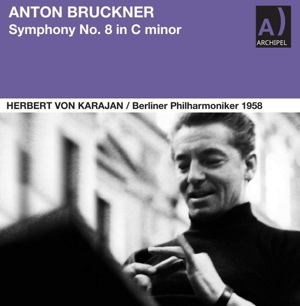
Anton Bruckner (1824-1896)
Symphony No. 8 in C minor WAB 108 (1887/90 mixed version ed. Haas)
Berliner Philharmoniker/Herbert von Karajan
rec. (1958?) 23-25/5/57, Grunewaldkirche, Berlin, Germany
Archipel ARPCD0836 [87]
I have long favoured Karajan’s last studio recording with the VPO as the best option for a recording of this symphony, with the 1975 BPO account coupled with this earliest studio version not far behind it. I was first puzzled when I saw the date “1958” on this new release from the “Archipel Desert Island Collection”, at first assuming it must be a live performance but quickly ascertained that this was not the case, as listening in combination with timing comparisons soon confirmed that this is in fact simply Archipel’s own “rip-off” (if you will excuse the vulgar term) of the famous EMI recording which has had numerous incarnations on various EMI and other labels – and most recently on Warner. This gives rise to the ignoble suspicion that Archipel might deliberately be obscuring the recording’s true identity by publishing it under the wrong date, thereby enhancing its desirability by implying that it is a different account from the one which has already been so long available…but perish the thought…
I must also say that I find in comparison with other digital remasterings, I find the sound here rather muddy in the lower reaches and a tad harsh and crackly up top, with a suggestion of congestion; I cannot be sure, but from the rumble and swish, it sounds to me as if this has been lifted from a stereo LP (it was first issued in mono and only later in stereo, in an expensive subscription.) The extraneous noise at the start of the Adagio is especially distracting and continues throughout; I instantly compared it with my own CD which is devoid of that rustle, if not quite as immediate. There will always inevitably be a bit of background hiss and it still sounds very good here, even if the Warner CD sound – and, indeed, a copy I have on the Minuet label – is a little darker, fuller and warmer – eminently listenable and certainly hardly identifiable as a product of the late 50s. The Grunewald church location might not have been the Jesus-Christus-Kirche but it was still very felicitous as a venue.
This is an important and historic recording for a number of reasons: it was Karajan’s first with the Berlin Philharmonic since he had become their Music Director following Furtwängler’s unexpected death in late 1954. Furthermore, its technical excellence is remarkable given that EMI’s Walter Legge was still wedded to mono technology and Karajan – extraordinarily, considering how he subsequently embraced technological advances with such fervour – was still persisting with a practice inherited from the 78 era and making four-minute takes before checking each one. Fortunately Legge took no interest in “new-fangled” stereo, believing it to be a passing phase and Karajan was persuaded otherwise by the engineering team from Electrola, Cologne, into making much longer takes – and the result was superb.
It is the longest of Karajan’s recordings, studio and live – it was in essence a “signature piece” and comparison across the three studio accounts is interesting:
| Date | Label | Allegro moderato | Scherzo | Adagio | Finale | Total |
| 23-25/5/57 | EMI | 17:05 | 16:04 | 27:31 | 26:17 | 86:59 |
| 1 & 4/75 | DG | 16:47 | 15:05 | 26:07 | 24:07 | 82:06 |
| 11/88 | DG | 16:56 | 16:25 | 25:13 | 23:59 | 82:49 |
Evidently, the duration of both Adagio and finale of the first recording is considerably longer but it never sounds laboured. Karajan was an absolute master of this symphony: the beauty of the orchestral playing, his sense of over-arching narrative, his command of building to overwhelming climaxes, his sustained concentration, communicated to his players, all made him a Brucknerian of a type rivalled perhaps only by Giulini. Other, more propulsive and dynamic exponents of Bruckner such as Knappertsbusch, Tennstedt and Schuricht, took a different – and arguably equally successful – route, but the grandeur of Karajan’s conception is unrivalled. His orchestra here is still Furtwängler’s – darker and more rugged than it subsequently became under his regime – but already a formidable sonic juggernaut. In no sense is it too “polished”; the brass in particular are so raucous and assertive – yet every note bespeaks massive commitment and unflagging musicality. It is hard to pin down the qualities Karajan brings to this music, but the rapt intensity of its execution is transmitted from conductor to orchestra to audience in a manner which is unmistakable and unrivalled. You know it at the first great climax in the Adagio at 7:44 and that sensation is no fluke; it recurs throughout whenever the music touches sublimity. The sighing, soughing reprise at 16:31 is ineffably tender then builds inexorably to a magnificent peroration at exactly twenty-two minutes; this is music-making on an epic scale. That sense of exaltation carries over into and pervades the finale; the sheer heroism of the music persists – as does the faint, intermittent crepitation – which is more of an annoyance on headphones. Any complaints? I would say that I am conscious of the deliberateness of Karajan’s tempo during the marching figure about five minutes in and more emphatic timpani would be welcome – but those are passing gripes. Certainly, as you may see from the table above, Karajan decided to inject slightly more momentum into his direction of the final movement but it does not sag and the coda is magical – like great gates swinging open to reveal an empyrean vista.
I cannot in all conscience endorse this Archipel issue as the most desirable – yet the beauty of Karajan’s conception endures in whatever guise you experience it – and remains true of whichever of his three studio recordings to encounter.
Ralph Moore
Help us financially by purchasing from


















